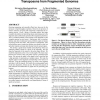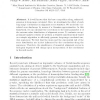280 search results - page 8 / 56 » A Sequence Alignment Model Based on the Averaged Perceptron |
BCB
2010
13 years 3 months ago
2010
Growing sequencing and assembly efforts have been met by the advances in high throughput machines. However, the presence of massive amounts of repeats and transposons complicates ...
CP
2003
Springer
14 years 1 months ago
2003
Springer
Multiple sequence alignment is a central problem in Bioinformatics. A known integer programming approach is to apply branch-and-cut to exponentially large graph-theoretic models. T...
RECOMB
2006
Springer
14 years 8 months ago
2006
Springer
It is well known that the base composition along eukaryotic genomes is long-range correlated. Here, we investigate the effect of such long-range correlations on alignment score sta...
ALMOB
2008
13 years 8 months ago
2008
Background: Protein structure alignments are usually based on very different techniques to sequence alignments. We propose a method which treats sequence, structure and even combi...
ICASSP
2010
IEEE
13 years 6 months ago
2010
IEEE
We investigate incremental word learning with few training examples in a Hidden Markov Model (HMM) framework suitable for an interactive learning scenario with little prior knowle...


